GFF partner Martin Joergensen's annual trip to Bornholm! A highlight in his fishing calendar and always a great trip no matter how lousy the fishing is. This year fishing was fine and the trip a success in spite of troublesome wind and a late and cold spring.
|
|
|
|
|
|
This annually recurring trip will celebrate its 10th anniversary next year, and has been a longstanding tradition amongst the crowd of merry pranksters that I usually go fishing with. The team has varied a bit over the years, but the core group of people has remained the same. Some of them will be well known faces to the regulars on GFF, often appearing in my images and stories, while others are less publicly exposed and have only been on a trip or two to that rocky island in the Baltic.
Earlier reports can be seen in
Rock Island
Bornholm 2002
I'm not going to make this a diary accounting for every day of our trip. As usual this won't be a kiss'n'tell story either, revealing all our "secret spots" on the island—as if we had any. For the most I will just let the pictures talk for themselves, and maybe intertwine the imagery with some small bits of text on more specific subjects.
|
|
|
|
|
|
|
|
|
|
|
|
The boots-just-barely-visible state
Most people who fish the ocean know that wind can be a real crucial factor to success. The wind can be troublesome in several respects, but waves and dirty water are the two main causes of grievance with head winds and the resulting casting trouble as a close number three.
Heavy winds will raise the ocean creating waves and stirring the water. That again will bring dirt, silt, seaweed and other stuff up into the water and make every cast a battle for not snagging on something in the water. While the fish probably couldn't care less (or maybe even prefer dirty water), we coastal anglers are quite distraught by the dirt.
On the other hand, when it settles and the murkiness of the water reaches a certain low level, we celebrate, because it's a well-known fact that the boots-just-barely-visible state of the water will create close to perfect conditions for sea trout fishing. The fish will be hunting ferociously in the shelter of the dirt and aggressively attack most things that move—including our flies... hopefully.
So provided that the wind isn't too rough and the waves aren't too high, we look for water with some "color" caused by the stirred-up bottom sediment. That is typically found on the shore where the wind was head on the day before.
The advantage of being on an island
Being on an island gives certain advantages when the fishing is sensitive to wind: there is always a calm side and always a windy side and logically also two sides with something in between.
So ideally the wind changes around, constantly creating shores where the wind was on the day before, or you wish for days with light winds on or along your favorite spots, rendering them with perfect small waves or ripples and some water movement.
Of course things are rarely perfect, and this year we basically had two choices: either we had to find small coves with shelter from the strong western and south-western wind or we had to go to the off wind side and fish water, which was still and clear as gin. Either situation is far from optimal. But at least we had the option.
The large number of fish
The surprisingly large number of sea trout on Bornholm is caused by several factors. The single most important one is the presence of many spawning streams. The small island has a couple of dozens of streams, where sea trout spawn, and that draws a lot of fish close to the shores during the winter. The strategy of these fish even enhances the chances of catching them on the coast. Because of the small size of the streams and the fact that they are all spate streams with very fickle and unstable water levels, the fish have to engage in a hit-and-run spawning strategy, entering the streams as soon as the water is there and exiting the stream again within a few days before the levels drop.
On this particular island the fish even have spread out their spawning over several months, meaning that some will spawn already in October while others will wait until early spring. All this to ensure the propagation of the species.
This means that most spawning fish will spend a long time in the ocean rather than in the stream and also means that they will be available to us as quarries.
Kelts – a blessing and a curse
After spawning the sea trout return to the ocean to feed and regain strength and weight. In this stage they are referred to as kelt, and are a different breed indeed compared to the silver bullet sea trout that we admire so much.
The kelt is typically slim, it's tail and fins are worn and the fish is deplete of energy from overcoming the hazards of the spawning run. Some are even attacked by different fungi and fin-rot. Many of them are barely recognizable as sea trout, but look like a different species.
Because of this they are often far from beautiful and actually quite bad fighters too. But they are often caught in large sizes since they are typically older fish.
The fish regain their strength and former beauty before autumn, and become the fish we connect with sea run sea trout: the silver bullet of the ocean – a beautiful chrome fish in prime condition.
|
|
|
|
|
|
|
|
|
The prize: a chrome fish
The fish we all hunt when we go fishing for sea trout in the ocean in the cold season is the perfect-bodied shiny fish in perfect condition. In the winter and early spring these are the ones that have skipped spawning and remained in the ocean during the winter to feed.
Fish like that fall in two groups: fish that haven't spawned and fish, which have been up into a stream to spawn one or several earlier years, but decided to skip this particular year.
The result is a fish, which has had more than one season to overcome the spawning perils and grow, and the end result of that is an extraordinarily strong and well-conditioned fish.
The smaller ones are pre-spawn fish, which have only spent a year or two in the ocean, but haven't spawned yet. These are equally beautiful, but just not as large as the first group.
Both are a great catch and will fight well, look very beautiful and even taste very well if you decide to keep one for the pan.
|
|
|
|
|
|
|
|
|
|
|
|
|
- Log in to post comments


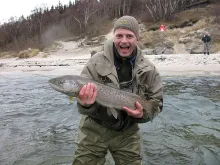












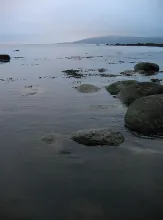
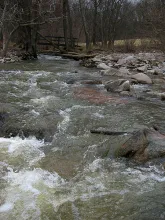






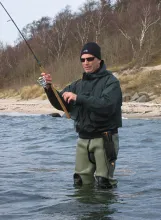








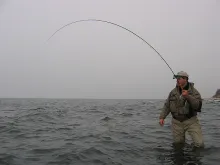




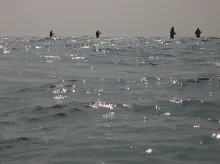



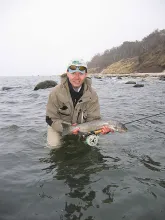











Wonderfull Place , a
Wonderfull Place , and Trout!!!!
Is good the and of April?
HAPPY CHRISTMASS
Beatiful report!
I'
Beatiful report!
I'm very interested to this spot; can you tell me something about the best period of the year?
Where were you located?
Can you suggest to me a B&B, lodge, ecc... near this wonderful sea?
Thank you and... I'm sorry for my English!
Bye
Massimo
Super! Looks like y
Super! Looks like you really captured the essence of the trip! Wish I was there!!!
Frederik,
The pic
Frederik,
The pictures are now available as a slideshow. Thanks for reminding me.
And sure it would be great with some more personal narrative for the trip. But it takes a lot of time to do these thorough articles, and accounting for seven and a half days of fishing amongst a group of seven guys is just beyond what I could muster the time for.
Next time maybe...
Martin
You really should ma
You really should make this article into a slideshow!
Nice pics but it would be fun with a more personal text.
kudos anyways!